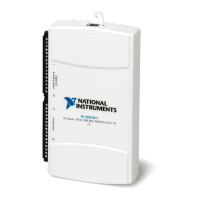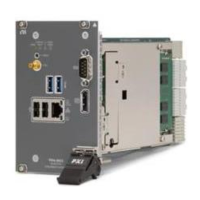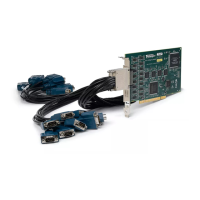© National Instruments | 2-11
NI 6612 User Manual
Hardware-Timed Generations
With a hardware-timed generation, a digital hardware signal controls the rate of the generation.
This signal can be generated internally on your device or provided externally.
Hardware-timed generations have several advantages over software-timed generations:
• The time between samples can be much shorter.
• The timing between samples can be deterministic.
• Hardware-timed acquisitions can use hardware triggering.
Hardware-timed operations can be buffered or hardware-timed single point (HWTSP). A buffer
is a temporary storage in computer memory for to-be-transferred samples.
• Hardware-timed single point (HWTSP)—Typically, HWTSP operations are used to
write single samples at known time intervals. While buffered operations are optimized for
high throughput, HWTSP operations are optimized for low latency and low jitter. In
addition, HWTSP can notify software if it falls behind hardware. These features make
HWTSP ideal for real time control applications. HWTSP operations, in conjunction with
the wait for next sample clock function, provide tight synchronization between the software
layer and the hardware layer. Refer to the document, NI-DAQmx Hardware-Timed Single
Point Lateness Checking, for more information. To access this document, go to
ni.com/
info and enter the Info Code daqhwtsp.
• Buffered—In a buffered generation, data is moved from a PC buffer to the device’s
onboard FIFO using DMA before it is written to the output lines one sample at a time.
Buffered generation typically allow for much faster transfer rates than non-buffered
acquisitions because data is moved in large blocks, rather than one point at a time.
One property of buffered I/O operations is the sample mode. The sample mode can be either
finite or continuous:
– Finite sample mode generation refers to the generation of a specific, predetermined
number of data samples. After the specified number of samples has been written out,
the generation stops.
– Continuous generation refers to the generation of an unspecified number of samples.
Instead of generating a set number of data samples and stopping, a continuous
generation continues until you stop the operation. There are several different methods
of continuous generation that control what data is written. These methods are
regeneration, FIFO regeneration, and non-regeneration modes:
• Regeneration is the repetition of the data that is already in the buffer. Standard
regeneration is when data from the PC buffer is continually downloaded to the
FIFO to be written out. New data can be written to the PC buffer at any time
without disrupting the output. Use the NI-DAQmx write property regenMode to
allow (or not allow) regeneration. The NI-DAQmx default is to allow
regeneration.
• With non-regeneration, old data is not repeated. New data must be continually written
to the buffer. If the program does not write new data to the buffer at a fast enough rate
to keep up with the generation, the buffer underflows and causes an error.

